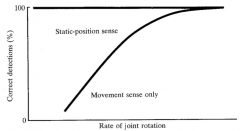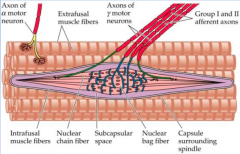![]()
![]()
![]()
Use LEFT and RIGHT arrow keys to navigate between flashcards;
Use UP and DOWN arrow keys to flip the card;
H to show hint;
A reads text to speech;
31 Cards in this Set
- Front
- Back
|
what is proprioception |
Perception of limb movement, body position and spatial orientation arising from stimuli within the body itself |
|
|
what 2 "senses" are involved in proprioception |
Movement sense or kinaesthesis - awareness of joint movement 2. Position sense - awareness of the static position of joints |
|
|
if e.g. your hand is moving slowly, will this be harder or easier to detect by the body through only movement sense/kinaesthesia proprioception? |

The slower the displacement velocity, the harder to detect a change in position if only movement sense available. |
|
|
proprioception is signalled through joint muscle and tissue, each of which have receptors that transmit signals during movement, what is the peripheral neural input of joints? |
in capsule and ligaments |
|
|
proprioception is signalled through joint muscle and tissue, each of which have receptors that transmit signals during movement, what is the peripheral neural input of muscle? |
-Muscle Spindle: primary and secondary endings -Tendon organ (receptor in muscle) |
|
|
proprioception is signalled through joint muscle and tissue, each of which have receptors that transmit signals during movement, what is the peripheral neural input of skin? |
slow adapting stretch receptors |
|
|
what proprioception receptors are present in muscles |
muscle spindle Tendon organ |
|
|
what proprioception receptors are present in joints |
Ruffini ending joint |
|
|
what are the angle of the joint when the limb is kept steady and the rate of change of the angle (angular veolcity) of joint both associated with directly |
the output frequency of the joint receptors |
|
|
is the output frequency of joint receptors is related to the angle of the joint if the limb is kept steady |
yes |
|
|
is the output frequency is related to the rate of change of the angle (angular velocity) when the joint is moved. |
yes |
|
|
what is the muscle spindle |
sensory receptors within the belly of a muscle that primarily detect changes in the length of this muscle
it is a complex sensory receptor with its own motor innervation (gamma (γ) motoneurones) that innervates intrafusal muscle fibres |
|
|
what are intrafusal muscle fibres innervated by |
(gamma (γ) motoneurones) |
|
|
what are extrafusal muscle fibres innervated by |

alpha (α) motoneurones |
|
|
what makes up the bulk of the muscle, the intrafusal muscle fibres or the extrafusal muscle fibres |
the extrafusal muscle fibres |
|
|
what are intrafusal muscle fibres |
Intrafusal muscle fibers are skeletal muscle fibers that serve as specialized sensory organs (proprioceptors) that detect the amount and rate of change in length of a muscle. They constitute the muscle spindle and are innervated by two axons, one sensory and one motor. |
|
|
what are extrafusal muscle fibres |
Extrafusal muscle fibers are the skeletal standard muscle fibers that are innervated by alpha motor neurons and generate tension by contracting, thereby allowing for skeletal movement. They make up large mass of skeletal (striated) muscle |
|
|
how does the alpha-gamma co-activation affect the intrafusal and extrafusal muscles |

|
|
|
what are the central neural inputs for how proprioception is signalled |
• Organs of balance • Semi-circular canals • Otolith organs • Visual input |
|
|
what is the vestibulo-ocular reflex |
The vestibulo-ocular reflex (VOR), also known as the oculocephalic reflex is a reflex eye movement that stabilizes images on the retinaduring head movement by producing an eye movement in the direction opposite to head movement, thus preserving the image on the center of the visual field.
-controlled by the semicircular canals |
|
|
vestibulo-ocular disturbance can lead to what condition? |
nystagmus (rapid involuntary movements of eye) |
|
|
what ear organs detect linear acceleration and (horizontal + vertical) and orientation in a gravitational field |
Otolith Organs (utricle and saccule) |
|
|
how can you test peripheral proprioception |
-clinical sensory examination -romberg test |
|
|
how would you assess joint hypermobility syndrome |
Threshold detection paradigm Knee moved by motor (0.4 deg/sec) and a blindfolded subject stops it when he/she is certain of the direction of movement. Small angular displacement = good proprioceptive acuity. Much more sensitive than standard clinical testing. |
|
|
in joint hypermobility syndrome (JHS), what is impaired |
kinaesthesia or the movement sense |
|
|
how would you go about testing the central proprioceptive input |
this is done by eliciting the vestibulo-Ocular reflex, the 2 methods used are -Barany chair -Caloric Testing |
|
|
Injection of water into the external auditory meatus (ear canal) leads to heat transfer and sets up convection currents in the semi-circular canals. Fluid movement in the canals stimulates hair cells which activates the Vestibulo-Ocular Reflex. This generates dizziness as a symptom and horizontal nystagmus as a sign of activation of the reflex. |
Due to inertia, head movement results in endolymph flow in the semi-circular canals. This deflects the cupula and stimulates hair cells. This in turn affects the extrinsic eye muscles. The vestibulo-ocular reflex stabilizes images on the retina during head movement by producing eye movement in the direction opposite to head movement (in all three planes). Powerful stimulation (e.g. fairground rides) elicits dizziness and nystagmus, and perhaps nausea and vomiting (motion sickness). Injecting water into the external auditory meatus sets up convection currents in the endolymph, the direction being temperature dependent. |
|
|
what conditions can cause vestibular dysfunction |
Labyrinthitis and vestibular neuritis (infection); Ménière’s disease |
|
|
what are the signs and symptomns of vestibular dysfunction |
Dizziness; vertigo; nausea; vomiting; loss of balance; nystagmus ...all pretty obvs ngl |
|
|
what signs and symptomns will impairment of proprioceptive feedback from the periphery lead to |
• Loss of balance; clumsiness; bumping into objects (usually door frames!); knees ‘giving way’; dropping objects • Often in common with other sensory disturbances (loss of fine touch, numbness, paraesthesia) due to neural injury |
|
|
what are the causes (aetiology) of impaired proprioception |
• Peripheral neuropathy - examples: • diabetes mellitus • alcohol abuse • Peripheral nerve injury • Spinal cord lesion • vitamin deficiency e.g. B12 , folate • trauma • Joint hypermobility syndrome |

